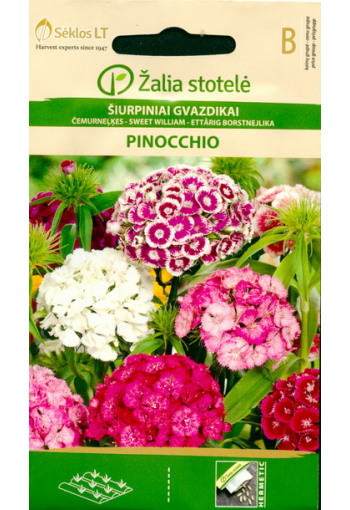Very attractive plants with dense white, pink and red flower caps. Bush is 50 cm high. Leaves linear-lanceolate, green.
By the end of the 1st year of cultivation, a rosette of basal leaves is formed. The next year, the plants bloom from the end of June for a month.
Used for prefabricated flower beds, rabatok and for cutting.
Agricultural technology.
The plant is cold and drought-resistant, and prefers a sunny place, but can also grow in partial shade. Grows well in well-drained soils.
Sowing of seeds is carried out in May-June in open ground on spreading ridges, lightly sprinkling them with wet sand. At a soil temperature of +18+20 °C shoots appear in 10-14 days. Seedlings are planted in a permanent place in August, maintaining a distance between plants of 25-30 cm.
1.0 g = 650-900 seeds.
* Dianthus barbatus is a favorite old cottage garden plant, a member of the carnation family. It is a bienniel or short-lived perennial, about 12-24 tall, easily grown from seed. It comes in shades of white, pink, red, black, and bicolors.
It is hardy to zone 4 and is not frost tender. It is in flower from July to August, and the seeds ripen from August to September. The scented flowers are hermaphrodite (have both male and female organs) and are pollinated by Bees and Lepidoptera (Moths & Butterflies). It is noted for attracting wildlife. We rate it 1 out of 5 for usefulness. The plant prefers light (sandy), medium (loamy) and heavy (clay) soils and requires well-drained soil. The plant prefers acid, neutral and basic (alkaline) soils. It cannot grow in the shade. It requires dry or moist soil.
Habitats and Possible Locations: Meadow, Woodland, Cultivated Beds, Sunny Edge.
Cultivation details: prefers a rich well-drained loamy soil in a sunny position, but succeeds in most soils including dry ones. A very ornamental plant, its flowers are very attractive to butterflies and moths. The flowers have a strong clove-like scent. Plants self-sow freely when grown in a suitable position.
Although the Sweet William is a perennial species, it is quite short-lived and degenerates after its second year. It is best treated as a biennial in the garden.
Propagation Seed: sow May/June in a cold frame. The seed usually germinates in 2 - 3 weeks. When they are large enough to handle, prick the seedlings out into individual pots and plant them out in the summer or autumn. The seed can also be sown thinly in an outdoor seedbed in late spring, the young plants being planted out in late spring or the autumn.
Cuttings of half-ripe shoots, July in a frame. Division in September. Larger clumps can be replanted direct into their permanent positions, though it is best to pot up smaller clumps and grow them on in a cold frame until they are rooting well. Plant them out in the spring.











